Related Research Articles
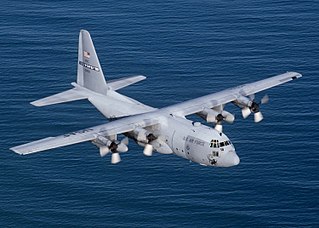
The Lockheed C-130 Hercules is an American four-engine turboprop military transport aircraft designed and built by Lockheed. Capable of using unprepared runways for takeoffs and landings, the C-130 was originally designed as a troop, medevac, and cargo transport aircraft. The versatile airframe has found uses in other roles, including as a gunship (AC-130), for airborne assault, search and rescue, scientific research support, weather reconnaissance, aerial refueling, maritime patrol, and aerial firefighting. It is now the main tactical airlifter for many military forces worldwide. More than 40 variants of the Hercules, including civilian versions marketed as the Lockheed L-100, operate in more than 60 nations.
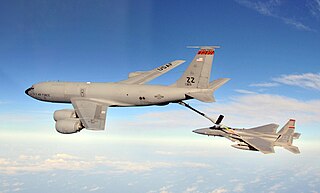
The Boeing KC-135 Stratotanker is an American military aerial refueling tanker aircraft that was developed from the Boeing 367-80 prototype, alongside the Boeing 707 airliner. It has a narrower fuselage and is shorter than the 707. Boeing gave the aircraft the internal designation of Model 717. The KC-135 was the United States Air Force (USAF)'s first jet-powered refueling tanker and replaced the KC-97 Stratofreighter. The KC-135 was initially tasked with refueling strategic bombers, but it was used extensively in the Vietnam War and later conflicts such as Operation Desert Storm to extend the range and endurance of US tactical fighters and bombers.

The Lockheed Martin EC-130 series comprises several slightly different versions of the Lockheed C-130 Hercules that have been and continue to be operated by the U.S. Air Force and, until the 1990s, the U.S. Navy.

Aerial refueling, also referred to as air refueling, in-flight refueling (IFR), air-to-air refueling (AAR), and tanking, is the process of transferring aviation fuel from one aircraft to another while both aircraft are in flight. The two main refueling systems are probe-and-drogue, which is simpler to adapt to existing aircraft, and the flying boom, which offers faster fuel transfer, but requires a dedicated boom operator station.
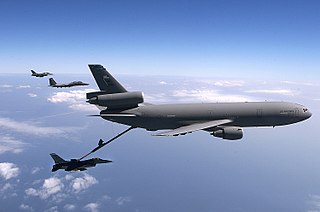
The McDonnell Douglas KC-10 Extender is an American tanker and cargo aircraft operated by the United States Air Force (USAF). A military version of the three-engine DC-10 airliner, the KC-10 was developed from the Advanced Tanker Cargo Aircraft Program. It incorporates military-specific equipment for its primary roles of aerial refueling and transport. It was developed to supplement the KC-135 Stratotanker following experiences in Southeast Asia and the Middle East. The KC-10 was the second McDonnell Douglas transport aircraft to be selected by the Air Force following the C-9. A total of 60 KC-10s were produced for the USAF. The Royal Netherlands Air Force operated two similar tankers designated KDC-10 that were converted from DC-10s.

The Lockheed HC-130 is an extended-range, search and rescue (SAR)/combat search and rescue (CSAR) version of the C-130 Hercules military transport aircraft, with two different versions operated by two separate services in the U.S. armed forces.

Future Strategic Tanker Aircraft (FSTA) is the name given to a British project to procure a fleet of Airbus A330 MRTT aerial refuelling (AR) and air transport (AT) aircraft for the Royal Air Force (RAF), to replace their then existing older models such as the Vickers VC10s and Lockheed TriStars.

The Lockheed MC-130 is the basic designation for a family of special mission aircraft operated by the United States Air Force Special Operations Command (AFSOC), a wing of the Air Education and Training Command, and an AFSOC-gained wing of the Air Force Reserve Command. Based on the Lockheed C-130 Hercules transport, the MC-130s' missions are the infiltration, exfiltration, and resupply of special operations forces, and the air refueling of (primarily) special operations helicopter and tilt-rotor aircraft.

The Airbus A330 Multi Role Tanker Transport (MRTT) is a European aerial refuelling and military transport aircraft based on the civilian Airbus A330. A total of 16 countries have placed firm orders for approximately 68 aircraft, of which 51 had been delivered by 30 November 2020. A version of the A330 MRTT, the EADS/Northrop Grumman KC-45, was selected by the United States Air Force for its aerial tanker replacement programme, but the programme was cancelled.

The McDonnell Douglas YC-15 is a replaced prototype four-engine short take-off and landing (STOL) tactical transport. It was McDonnell Douglas' entrant into the United States Air Force's Advanced Medium STOL Transport (AMST) competition to replace the Lockheed C-130 Hercules as the USAF's standard STOL tactical transport. In the end, neither the YC-15 nor the Boeing YC-14 was ordered into production, although the YC-15's basic design would be used to form the successful McDonnell Douglas C-17 Globemaster III.
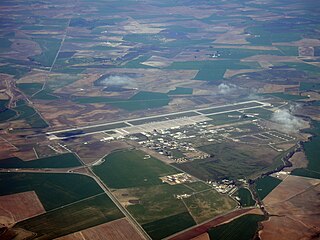
Morón Air Base is located at 37°10′N5°36′W in southern Spain, approximately 35 miles (56 km) southeast of the city of Seville. The base gets its name from the nearby town of Morón de la Frontera, while it is located inside the municipality of Arahal.
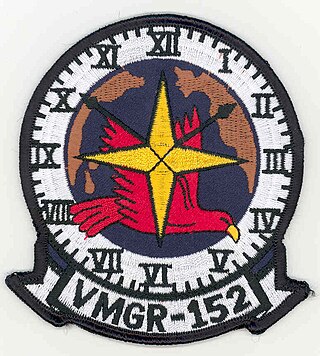
Marine Aerial Refueler Transport Squadron 152 (VMGR-152) provides aerial refueling service to support Fleet Marine Force (FMF) air operations; and provides assault air transport of personnel, equipment, and supplies. The squadron, known as the "Sumos", flies the fixed-wing Lockheed Martin KC-130J aircraft. VMGR-152 is stationed at Marine Corps Air Station Iwakuni, Iwakuni, Japan and is part of Marine Aircraft Group 12 (MAG-12) and the 1st Marine Aircraft Wing.

Marine Aerial Refueler Transport Squadron 352 (VMGR-352) is a United States Marine Corps KC-130J squadron. They are a part of Marine Aircraft Group 11 (MAG-11), 3rd Marine Aircraft Wing and provide both fixed-wing and rotary-wing aerial refueling capabilities to support Fleet Marine Force (FMF) air operations in addition to assault air transport of personnel, equipment, and supplies. The squadron, known as the "Raiders" is stationed at Marine Corps Air Station Miramar, California.

The Kuwait Air Force is the air arm of the Armed Forces of Kuwait. The Air Force headquarters is located at Abdullah Al-Mubarak Air Base, with the remaining forces stationed at Air Defense Brigades, Ali Al Salem Air Base and Ahmad al-Jaber Air Base. The Kuwait Air Force numbers approximately 2,500 officers and enlisted personnel.
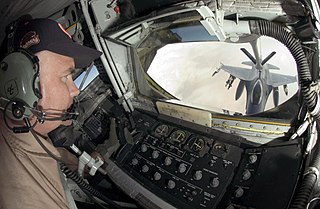
In the U.S. Air Force (USAF), a boom operator is an aircrew member aboard tanker aircraft who is responsible for safely and effectively transferring aviation fuel from one military aircraft to another during flight. The name boom operator implies that one "operates a boom", which is a long, extendable metal arm attached to the rear underside of the tanker that the boom operator connects to the fuel receptacle of a receiving aircraft. The boom operator also controls the refueling drogue, a basket attached to a flexible hose that trails the tanker, when using the probe-and-drogue system. The USAF officially designates the boom operator career field as "In-Flight Refueling" with a specialty code of 1A0X1. However, this designation is usually reserved for administrative paperwork such as enlistment contracts and performance reports, as boom operators themselves are rarely referred to as in-flight refueling specialists within the USAF. The title "Boom Operator" is most commonly used, in reference to the aircrew position they occupy on the airplane, as noted in USAF regulations and aircraft flight manuals. Fellow crew members affectionately address them as "boom" or "boomer".

The EADS/Northrop Grumman KC-45 was a proposed aerial refueling tanker aircraft based on the Airbus A330 MRTT. The United States Air Force (USAF) had ordered 179 KC-45As in the first stage of replacing the aging Boeing KC-135 Stratotanker tankers currently in service. However, the contest was reopened in July 2008, after Boeing's protest of the award was upheld. In response to the new contest, on 8 March 2010, Northrop Grumman announced it was abandoning its bid for the new contract, with its CEO stating that the revised bid requirement favoured Boeing. On 20 April 2010, EADS announced it was re-entering the competition and entered a bid with the KC-45. Eventually, the USAF selected the Boeing KC-46 Pegasus.

The Lockheed Martin C-130J Super Hercules is a four-engine turboprop military transport aircraft. The C-130J is a comprehensive update of the Lockheed C-130 Hercules, with new engines, flight deck, and other systems.

The Lockheed MartinKC-130 is a family of the extended-range tanker version of the C-130 Hercules transport aircraft. The KC-130J is the latest variant operated by the United States Marine Corps (USMC), with 48 delivered out of 79 ordered. It replaced older KC-130F, KC-130R, and KC-130T variants for aerial refueling. USMC reserve unit, VMGR-452 operated 12 KC-130T aircraft until May 2021; this was the last USMC reserve unit that operated the legacy KC-130s, completing the corps' transition to the more advanced Super Hercules.
The Lockheed Aequare was an unmanned aerial vehicle developed by the Lockheed Missiles and Space Company for the United States Air Force. It was intended for launch from an F-4 Phantom II fighter-bomber, and would carry a remote sensor array and laser designator for use by the launching aircraft. The system was evaluated in the mid 1970s, but did not enter operational service.
Operation Centennial Contact was an operation of the United States Air Force and National Guard conducted on 27 June 2023 to commemorate the 100-year anniversary of the first aerial refueling. Aircraft from various bases conducted aerial refueling exercises across the United States, as well conducting flyovers in 50 states. 152 aircraft were slated to participate in the operation, with 82 tanker aircraft providing refueling support to 70 other participating aircraft.
References
- ↑ BNET Sargent Fletcher Company Profile
- 1 2 "Sargent Fletcher Inc". Jane's . Jane's Aircraft Upgrades. November 3, 2008. Archived from the original on 2012-09-13.
- ↑ Sullivan, Deborah (1994-10-27). "Health Effects of Sargent-Fletcher Plant Are Hard to Discern: Chrome-plating factory reported toxic emissions at the highest level in the area. But the company disputes the data, citing smog as a more probable reason for neighbor's breathing ailments". Los Angeles Times .
- ↑ Navy Expects KC-130J Deliveries Under Revised Refueling Pod Plan Defense Daily, April 11, 2003 [ dead link ]
- ↑ "FAQ". Omega Aerial Refueling Services .